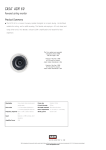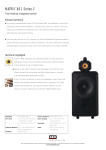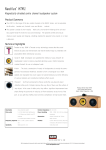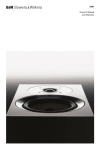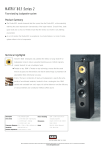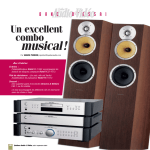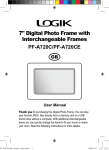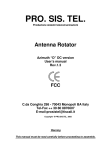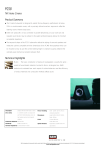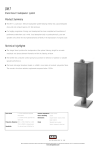Download Owner`s Manual - B&W Group North America Service & Support
Transcript
NautilusTMSCM1 Owner’s Manual and Warranty Figure 1 Figure 3a Figure 2 Figure 4b Figure 4a 0.5m –1m 110° –130° Figure 5a Figure 5b Figure 3b Figure 6 Figure 7 ~ ~ >1.5m ~ ~ >0.5m ~ ~ Figure 8a Figure 8b 16mm 150mm 44mm Figure 9a Figure 9b Contents English Limited Warranty...........2 Owner’s Manual............2 Dansk Begrænset garanti ......21 Brugsanvisning ...........21 Français Garantie limitée.............4 Manuel d’utilisation .......4 Svenska Begränsad garanti ......23 Bruksanvisning ...........23 Deutsch Beschränkte Garantie .......................7 Bedienungsanleitung.....7 Ελληνικά Περιορισµένη εγγύηση ....................25 Οδηγίες Χρήσεως ....26 Español Garantía limitada.........10 Manual de instrucciones ..............10 Русский Ограниченная гарантия....................29 Руководство по эксплуатации ............29 Português Garantia limitada.........13 Manual do utilizador....13 Italiano Garanzia limitata .........15 Manuale di istruzioni ...16 Nederlands Beperkte garantie .......18 Handleiding ................18 .......................32 .....................32 .......................34 ....................34 1 English where the equipment can be serviced. You can call B&W in the UK or visit our web site to get the contact details of your local distributor. Limited Warranty Dear customer, Welcome to B&W. This product has been designed and manufactured to the highest quality standards. However, if something does go wrong with this product, B&W Loudspeakers and its national distributors warrant free of charge labour (exclusion may apply) and replacement parts in any country served by an official B&W distributor. This limited warranty is valid for a period of five years from the date of purchase or two years for electronics including amplified loudspeakers. Terms and Conditions 1 The warranty is limited to the repair of the equipment. Neither transportation, nor any other costs, nor any risk for removal, transportation and installation of products is covered by this warranty. 2 This warranty is only valid for the original owner. It is not transferable. To validate your warranty, you will need to produce this warranty booklet completed and stamped by your dealer on the date of purchase. Alternatively, you will need the original sales invoice or other proof of ownership and date of purchase. Owner’s manual Introduction Thank you for choosing B&W. Your Nautilus™800 Series speakers are precision transducers incorporating many innovative techniques unique to B&W and capable of reproducing recorded sound to the highest standards. So that they may perform at their best, it is essential to take time and care with the installation process. In particular, you must regard the listening room as an extension of the speaker. The acoustic character of the room can have a profound effect on the final sound quality. The Nautilus™SCM1 is a shallow speaker designed for on-wall mounting, primarily for surround channel use in conjunction with other Nautilus™800 Series speakers. However, it may be used wherever a shallow speaker is required, but bearing in mind the comments below on magnetic shielding. 3 This warranty will not be applicable in cases other than defects in materials and/or workmanship at the time of purchase and will not be applicable: a for damages caused by incorrect installation, connection or packing, b for damages caused by any use other than correct use described in the user manual, negligence, modifications, or use of parts that are not made or authorised by B&W, B&W maintains a network of dedicated distributors in over 60 countries who will be able to help you should you have any problems your dealer cannot resolve. c for damages caused by faulty or unsuitable ancillary equipment, Unpacking (figure 1) d for damages caused by accidents, lightning, water, fire heat, war, public disturbances or any other cause beyond the reasonable control of B&W and its appointed distributors, When bi-wiring, do not use the linking cables. Take extra care with the polarity of the connections as incorrect connection can also impair the frequency response through the crossover and, if the links are left in place, may cause damage to the amplifier by shorting its output terminals. Lift the carton clear of the contents. Stray magnetic fields • Remove the inner packing from the product. The speaker drive units create stray magnetic fields that extend beyond the boundaries of the cabinet. We recommend you keep magnetically sensitive articles (television and computer screens, computer discs, audio and video tapes, swipe cards and the like) at least 0.5m from the speaker. if repairs or modifications have been executed by an unauthorised person. 4 This guarantee complements any national/regional law obligations of dealers or national distributors and does not affect your statutory rights as a customer. 4 1 2 2 8 Check in the carton for: terminal link cables cleaning cloth aluminium wall plates aluminium support plates self adhesive rubber pads Polythene bag containing: Should service be required, please follow the following procedure: 8 M5 socket screws 2 M8 socket screws 3mm Allen key 6mm Allen key Warranty booklet 1 Connections 2 Ensure each positive terminal on the speaker (coloured red) is connected to the positive output terminal of the amplifier and negative (coloured black) to negative. Incorrect connection can result in poor imaging and loss of bass. • f If the equipment is being used outside the country of purchase, you should contact B&W national distributor in the country of residence who will advise When using the links, insert the spade into the slot in the side of one terminal and the crimped pin into the round side hole in the other. There is enough clearance to insert a spade connector from the amplifier into the same terminal as the crimped pin. Ascertain the optimum position for the speaker before fixing the mounting bracket to the wall. We suggest you retain the packing for future use. 2 Should you not want to bi-wire, perhaps during the initial set-up procedure or because you do not want to see a multitude of cables in the room, short cables are provided to link both positive and both negative speaker terminals together. (figure 3) Fold the carton flaps right back and invert the carton and contents. • for products whose serial number has been altered, deleted, removed or made illegible, If the equipment is being used in the country of purchase, you should contact the B&W authorised dealer from whom the equipment was purchased. Bi-wiring is the preferred method of connection and involves the use of separate cables from the amplifier to each pair of terminals. The separation of the signal paths improves the resolution of lowlevel detail and allows the user to optimise the type of cable to the frequency range of use. (figure 2) Positioning e How to claim repairs under warranty The terminals are insulated to prevent any likelihood of electrical shock, even when the speakers are used with the highest powered amplifiers, and accept a variety of cable terminations to suit most applications. All connections should be made with the equipment switched off. There are 2 pairs of terminals at the back of the speaker to permit bi-wiring. The lower pair feed the bass/midrange drive unit and the upper pair feed the tweeter. For this reason, the Nautilus™SCM1 is only suitable for use as a centre speaker when using either projection, plasma or LCD screens which are not affected by stray magnetic fields. Home Theatre As a surround speaker: There are two main ways of presenting surround information. Older movie soundtracks, where the surround information was recorded on only one channel, benefited from a very ambient, all-enveloping presentation from the surround speakers, with little attempt to portray precise imaging to the sides and rear. More modern 5.1 channel recordings of both movies and audio have discrete left and right surround channels, which can convey more precise imaging. However, images to the sides and rear are not generally as precise as can be obtained at the front. Sustained tones can be more readily positioned between the speakers than percussive sounds, which have a tendency to collapse towards the speakers. It is also difficult to maintain image position for all listeners if the listening area is a significant proportion of the area between the five speakers. Image stability depends on getting the right balance between all five speakers and the ‘hot spot’ effect is even more marked than for 2-channel audio. With this in mind, your success in recreating the producer’s intentions for the surround field will depend to a great extent on domestic constraints – how free you are to position the speakers in an ideal position and how large an audience you want to cater for, relative to the size of the room. There is no industry standard for the angle subtended by the surround speakers at the listening position, but most recordings are made with the surround speakers positioned between 110° and 130° from front centre. Place the speakers against the wall within this range of angles, initially on a temporary support that raises the tweeters approximately to ear height. This will define whether you position the speakers on the side or rear wall. Point the speakers towards the centre of the listening area. (figure 4) The wall bracket will allow the speaker to be rotated horizontally up to 45°. If you listen in high-backed chairs, or if the speakers are otherwise obscured, it may be advantageous to raise them higher. Satisfactory results can be obtained with them up to approximately 60cm (2 feet) above ear height. With all speakers positioned for initial listening tests, listen to a wide variety of programme material – 5.1 channel audio, action and small scale movies – and sit in all likely listening positions. Pay particular attention to the surround information and the stability of the images. If the imaging is unsatisfactory, for example if it becomes too one sided at the extremes of the listening area, or if you cannot place the speakers within the preferred range, you may be better off aiming for a more diffuse sound field. This can give more acceptable results in difficult situations. Try changing the angle of the speakers so they point away from the listening area. It may also be advantageous to raise the speakers well above ear height. (figure 5) Once you have found the optimum position, fix the speaker permanently in position (see below). As a front centre speaker: If using a projection television with an acoustically transparent screen, place the speaker behind the centre of the screen. Otherwise position it directly above or below the screen, whichever is closest to ear level. As a front left and right speaker: Space the speaker between 0.5m (20 in) and 1m (40 in) from the side of the screen. If the centre speaker is behind an acoustically transparent screen, position the left and right front speaker as nearly as possible at the same height. If the centre speaker is above or below the screen, the height of the left and right speaker should be between the height of the centre speaker and the centre of the screen. Adjust the angle of the speakers to achieve the most realistic and stable image. For greatest realism in home theatre installations it is important to balance the speakers and adjust the acoustic image to match the size of the screen. With smaller screens it may be more realistic to have the left and right speakers closer together than you might for audio alone. Adjust the levels of the three front speakers to get a smooth transition of sounds as they pan across the screen. Adjust the level of the surround speakers so that, except for special effects, your attention is not unduly attracted to them. Sit in all likely listening positions when deciding on the optimum levels. Consult your decoder manual for further information on how to set the levels. 2-Channel Audio Mount the speakers so that the tweeters are approximately at ear level. As an initial guide: (figure 6) Position the speakers and the centre of the listening area approximately at the corners of an equilateral triangle. Keep the speakers at least 1.5m apart to maintain left-right separation. mechanical properties. The drive unit suspensions will also loosen up during the first hours of use. The time taken for the speaker to achieve its intended performance will vary depending on previous storage conditions and how it is used. As a guide, allow up to a week for the temperature effects to stabilise and 15 hours of average use for the mechanical parts to attain their intended design characteristics. Assembling and fixing the bracket Screws and plugs for fitting to the wall are not supplied. Use round head screws with a maximum body diameter of 5.0mm (0.20 in) and a maximum head diameter of 11mm (0.4 in). Drill and plug two holes in the wall, 150mm (5.9 in) above where the bottom of the speaker cabinet will be and horizontally spaced by 44mm (1.73 in). (figure 8a) Take special care, especially if fitting into drywall panels, that the screws and plugs can support the combined weight of the speaker and bracket. Insert the screws into the wall leaving the head 16mm (0.6 in) clear of the surface. (figure 8b) Assemble the support plate to the wall plate using the four M5 screws and the 4mm Allen key. (figure 9a) Feed the M8 screw through the slot in the support plate into the threaded insert in the bottom panel of the enclosure, using the 6mm Allen key. (figure 9b) Initially, position the screw at the end of the slot furthest from the wall plate so that the keyhole slots are clearly visible. If the central image is poor, try moving the speakers closer together or toeing them in so they point at or just in front of the listeners. (figure 7) Connect the cables to the speaker and hook the wall plate over the screws in the wall. Fine Tuning Adjust the speaker to be as close to the wall as possible, commensurate with the angle of rotation. Before fine tuning, double check that all the connections in the installation are correct and secure. If the sound is too harsh, increase the amount of soft furnishing in the room (for example use heavier curtains), or reduce it if the sound is dull and lifeless. Test for flutter echoes by clapping your hands and listening for rapid repetitions. Reduce them by the use of irregular shaped surfaces such as bookshelves and large pieces of furniture. For the most discerning listening, remove the cloth covered grille as described below in the section ‘Aftercare’. The tweeter is very delicate and its grille should be left in position for protection. For this reason the grille retaining ring is designed to provide the optimum acoustic environment for the unit and the response is less smooth with the grille removed. Running-in period The performance of the speaker will change subtly during the initial listening period. If the speaker has been stored in a cold environment, the damping compounds and suspension materials of the drive units will take some time to recover their correct Should you need to adjust the vertical angle of the speaker, we recommend you use an Omnimount 30.0 WB Series wall bracket in place of the one supplied. It may be fitted to the additional 4 threaded inserts in the base of the speaker. Ancillary equipment Speakers of this ability deserve signals of the highest quality. Choose your electronic equipment and interconnecting cables with care. We can give guidance on what to look for when choosing ancillary equipment, but cannot recommend specific items. The standards of such products are improving all the time and your dealer will be able to demonstrate a variety of suitable up-to-date products. In the specification we recommend a range of amplifier powers. The higher figure is defined by the power handling capability of the speaker. When calculating the power handling, it is assumed that the amplifier is not run into clipping, which distorts the frequency power spectrum of the signal, and that the signal is normal programme material. Test tones from oscillators and the like are not applicable. The lower figure is the minimum we consider necessary to 3 achieve reasonable listening levels without audible distortion in the smaller room (less than 50 m3 or 1800 cu ft). The higher the power you use, the less likely you are to experience amplifier clipping. You can often tell how good an amplifier is at driving complex speaker loads by looking at its power rating into both 4Ω and 8Ω loads. The nearer the ratio is to 2:1 the better, as it indicates a good current capability. In order to reduce the effect the cable has on the frequency response of the speaker to inaudible levels, the impedance of the cable at all frequencies (measuring both positive and negative conductors in series) should be kept as low as possible and certainly below 0.1Ω. At low frequencies, the DC resistance of the cable is the dominant factor and you should choose a gauge of wire sufficient to achieve the impedance requirements over the length of cable you need to use. At mid and high frequencies the inductive component of the impedance can dominate the DC resistance. This and other properties influenced by the detailed construction of the cable become important. Ask your dealer for advice on the best cable for your needs. Aftercare The cabinet surface usually only requires dusting. If you wish to use an aerosol cleaner, remove the grille first by gently pulling it away from the cabinet. Spray onto the cleaning cloth, not directly onto the cabinet. The grille fabric may be cleaned with a normal clothes brush whilst the grille is detached from the cabinet. Avoid touching the drive unit diaphragms, especially the tweeter, as damage may result. Français Si l’équipement est utilisé dans le pays d’achat, veuillez contacter le distributeur agréé de B&W qui a vendu l’équipement. 2 Si l’équipement est utilisé dans un pays autre que le pays d’achat, veuillez contacter le distributeur national B&W du pays de résidence, qui vous indiquera où vous pouvez faire réparer l’équipement. Vous pouvez appeler B&W au Royaume-Uni ou consulter notre site Web pour obtenir les coordonnées de votre distributeur local. Garantie limitée Cher Client, Bienvenue à B&W. Ce produit a été conçu et fabriqué en vertu des normes de qualité les plus rigoureuses. Toutefois, en cas de problème, B&W Loudspeakers et ses distributeurs nationaux garantissent une main d’œuvre (exclusions possibles) et des pièces de rechange gratuites dans tout pays desservi par un distributeur agréé de B&W. Cette garantie limitée est valide pour une période de cinq ans à compter de la date d’achat ou une période de deux ans pour les composants électroniques, y compris les haut-parleurs amplifiés. Afin de valider votre garantie, vous devrez présenter ce livret de garantie qui aura été rempli et tamponné par votre revendeur le jour de l’achat. En l’absence de ce livret, vous devrez présenter l’original de la facture commerciale ou une autre preuve d’achat et de la date d’achat. Conditions 1 La garantie est limitée à la réparation de l’équipement. Les frais de transport ou autres, les risques associés à l’enlèvement, au transport et à l’installation des produits ne sont pas couverts par cette garantie. 2 La garantie est exclusivement réservée au propriétaire d’origine et ne peut pas être transférée. 3 Cette garantie ne s’applique qu’aux produits faisant l’objet de vices de matériaux et/ou de construction au moment de l’achat et ne sera pas applicable dans les cas suivants : a détériorations entraînées par une installation, connexion ou un emballage incorrect, b détériorations entraînées par un usage autre que l’usage correct décrit dans le manuel de l’utilisateur, la négligence, des modifications ou l’usage de pièces qui ne sont pas fabriquées ou agréées par B&W, c détériorations entraînées par un équipement auxiliaire défectueux ou qui ne convient pas, d détériorations résultant de : accidents, foudre, eau, chaleur, guerre, troubles de l’ordre public ou autre cause ne relevant pas du contrôle raisonnable de B&W ou de ses distributeurs agréés, e les produits dont le numéro de série a été modifié, effacé, éliminé ou rendu illisible, f les produits qui ont été réparés ou modifiés par une personne non autorisée. 4 cette garantie vient en complément à toute obligation juridique nationale / régionale des revendeurs ou distributeurs nationaux et n’affecte pas vos droits statutaires en tant que client. Comment faire une réclamation en vertu de la garantie Veuillez respecter la procédure ci-dessous, si vous souhaitez faire une réclamation sous garantie : 4 1 Manuel d’utilisation Introduction Nous vous remercions d’avoir choisi B&W. Vos enceintes acoustiques de la série Nautilus™800 sont des transducteurs de précision, comprenant de nombreuses techniques innovantes, uniques à B&W. Elles sont capables de reproduire vos enregistrements au niveau de qualité le plus élevé. Pour obtenir les meilleures performances, il est essentiel de consacrer le temps et l’attention nécessaires à leur installation. En premier lieu, vous ne devez jamais oublier que la salle d’écoute est une extension acoustique des enceintes. Le tempérament acoustique de la salle peut donc avoir une influence profonde sur la qualité sonore finale. La Nautilus™SCM1 est une enceinte peu profonde, conçue pour être posée contre un mur. Elle est destinée, à l’origine, à la reproduction des informations d’ambiances d’une installation “Surround” équipée d’autres enceintes de la série “Nautilus™800”. Elle peut être utilisée, toutefois, en tant qu’enceinte principale lorsque la profondeur disponible n’est pas très importante. Dans ce cas, il suffira de garder à l’esprit les conseils que nous formulons plus loin quant à l’émission de champs magnétiques parasites. B&W a constitué un réseau de distributeurs dans plus de 60 pays. Ils sont en mesure de vous assister au cas où votre revendeur ne pourrait vous aider. Deballage (figure 1) • Repliez complètement les abattants puis retournez le carton avec son contenu. • Soulevez le carton seul. • Retirez l’emballage intérieur. Nous vous suggérons de conserver cet emballage pour une prochaine utilisation. NautilusTMSCM1 36 Technical Features Nautilus™ tweeter Kevlar® brand fibre cone bass/midrange Matrix cabinet Flowport Bracket for on-wall mounting included Description 2-way vented-box system Drive units 1x ø25mm (1in) alloy dome high-frequency 1x ø165mm (6.5in) woven Kevlar® bass/midrange Frequency range -6dB at 50Hz and 30kHz -3dB at 70Hz and 22kHz Frequency response 80Hz – 20kHz ±2dB on reference axis Dispersion Within 2dB of response on reference axis Horizontal: over 40° arc Vertical: over 10° arc Sensitivity 89dB spl (2.83V, 1m) Harmonic distortion 2nd & 3rd harmonics (90dB spl, 1m) <1.0% 100Hz – 20kHz <0.5% 200Hz – 18kHz Nominal impedance 8Ω (minimum 4.7Ω) Crossover frequencies 4kHz Power handling 50W –120W into 8Ω on unclipped material Max. recommended cable impedance 0.1Ω Dimensions Height: Width: Depth: Net Weight 8.0kg (17.6 lb) 437mm (17.2 in) 372mm (14.7 in) 167mm (6.6 in) not including wall bracket II09318 Issue 1 B&W Loudspeakers Ltd Dale Road Worthing West Sussex BN11 2BH England T +44 (0) 1903 221800 F +44 (0) 1903 221801 [email protected] www.bwspeakers.com UK Sales Enquiries and Service T +44 1903 221 500 E [email protected] B&W Loudspeakers of America T +1 978 664 2870 E [email protected] B&W Loudspeakers (Asia) Ltd T +852 2 790 8903 E [email protected] Kevlar is a registered trademark of DuPont. Nautilus is a trademark of B&W Loudspeakers Ltd. Copyright © B&W Loudspeakers Ltd. E & OE Design by Thomas Manss & Company. Printed in Spain.










